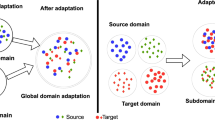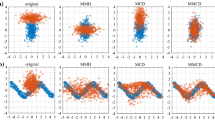Abstract
Unsupervised domain adaptation, which aims to classify a target domain correctly only using a labeled source domain, has achieved promising performance yet remains a challenging problem. Most traditional methods focus on exploiting either geometric or statistical characteristics to reduce domain shifts. To take advantage of both sides, in this paper, we propose a unified framework incorporating both the geometric and statistical characteristics by adopting the non-convex Schatten p-norm and graph Laplacian constraints to preserve global and local structure information and constructing marginal and conditional distribution minimization terms to reduce the distribution shifts. Moreover, a classification error term on the source domain is embedded into the objective function to increase the discriminability. The proposed method has been evaluated on six datasets and the experimental results demonstrate the superiority of the proposed method over several state-of-the-art methods. The MATLAB code of our method will be publicly available at https://github.com/HeyouChang/unsupervised-domain-adaptation.








Similar content being viewed by others
References
Chang H, Luo L, Yang J, Yang M (2016) Schatten p-norm based principal component analysis. Neurocomputing 207:754–762
Chang H, Zhang F, Gao G, Zheng H (2019) Structure-constrained discriminative dictionary learning based on Schatten p-norm for face recognition. Digital Signal Process 95
Ding Z, Fu Y (2018) Deep transfer low-rank coding for cross-domain learning. IEEE Trans Neural Netw Learn Syst 30(6):1768–1779
Ghifary M, Balduzzi D, Kleijn W, Zhang M (2017) Scatter component analysis: a unified framework for domain adaptation and domain generalization. IEEE Trans Pattern Anal Mach Intell 39(7):1414–1430
Gong B, Shi Y, Sha F, Grauman K (2012) Geodesic flow kernel for unsupervised domain adaptation. In: CVPR, pp 2066–2073
Kobylarz J, Bird JJ, Faria DR, Ribeiro EP, Ekárt A (2020) Thumbs up, thumbs down: non-verbal human-robot interaction through real-time emg classification via inductive and supervised transductive transfer learning. J Ambient Intell Humaniz Comput 1–11
Lan R, Lu H, Zhou Y, Liu Z, Luo X (2019) An lbp encoding scheme jointly using quaternionic representation and angular information. Neural Comput Appl 1–7
Liu G, Lin Z, Yan S, Sun J, Yu Y, Ma Y (2013) Robust recovery of subspace structures by low-rank representation. IEEE Trans Pattern Anal Mach Intell 35(1):171–184
Long M, Ding G, Wang J, Sun J, Guo Y, Yu PS (2013a) Transfer sparse coding for robust image representation. In: CVPR, pp 407–414
Long M, Wang J, Ding G, Sun J, Yu PS (2013b) Transfer feature learning with joint distribution adaptation. In: ICCV, pp 2200–2207
Long M, Zhu H, Wang J, Jordan MI (2017) Deep transfer learning with joint adaptation networks. In: ICML, pp 2208–2217
Lu H, Li Y, Mu S, Wang D, Kim H, Serikawa S (2018) Motor anomaly detection for unmanned aerial vehicles using reinforcement learning. IEEE Internet Things J 5(4):2315–2322
Lu H, Wang D, Li Y, Li J, Li X, Kim H, Serikawa S, Humar I (2019) Conet: a cognitive ocean network. IEEE Wirel Commun 26(3):90–96
Nie F, Huang H, Ding C (2012) Low-rank matrix recovery via efficient Schatten p-norm minimization. In: AAAI, pp 655–661
Razzaghi P, Razzaghi P, Abbasi K (2019) Transfer subspace learning via low-rank and discriminative reconstruction matrix. Knowl Based Syst 163:174–185
Shao M, Kit D, Fu Y (2014) Generalized transfer subspace learning through low-rank constraint. Int J Comput Vis 109(1–2):74–93
Si S, Tao D, Geng B (2010) Bregman divergence-based regularization for transfer subspace learning. IEEE Trans Knowl Data Eng 22(7):929–942
Singh A, Nigam A (2019) Effect of identity mapping, transfer learning and domain knowledge on the robustness and generalization ability of a network: a biometric based case study. J Ambient Intell Humaniz Comput 11:1905–1922
Singh R, Ahmed T, Singh R, Udmale SS, Singh SK (2019) Identifying tiny faces in thermal images using transfer learning. J Ambient Intell Humaniz Comput 11:1957–1966
Sun B, Saenko K (2015) Subspace distribution alignment for unsupervised domain adaptation. In: BMVC, pp 24.1–10
Wang J, Chen Y, Hao S, Feng W, Shen Z (2017) Balanced distribution adaptation for transfer learning. In: ICDM, pp 1129–1134
Wang J, Feng W, Chen Y, Yu H, Huang M, Yu PS (2018a) Visual domain adaptation with manifold embedded distribution alignment. In: ACM MM, pp 402–410
Wang J, Wang H, Gao G, Lu H, Zhang Z (2019) Single underwater image enhancement based on \(\text{ l}_p\) -norm decomposition. IEEE Access 7:1145199–145213
Wang L, Ding Z, Fu Y (2018b) Low-rank transfer human motion segmentation. IEEE Trans Image Process 28(3):1023–1034
Wright J, Yang AY, Ganesh A, Ma Y (2009) Robust face recognition via sparse representation. IEEE Trans Pattern Anal Mach Intell 31(2):210–227
Xiao T, Liu P, Zhao W, Liu H, Tang X (2019) Structure preservation and distribution alignment in discriminative transfer subspace learning. Neurocomputing 337:218–234
Xu X, Lu H, Song J, Yang Y, Shen H, Li X (2019) Ternary adversarial networks with self-supervision for zero-shot cross-modal retrieval. IEEE Trans Cybern
Xu Y, Fang X, Wu J, Li X, Zhang D (2016) Discriminative transfer subspace learning via low-rank and sparse representation. IEEE Trans Image Process 25(2):850–863
Yang J, Chu D, Zhang L, Xu Y, Yang J (2013) Sparse representation classifier steered discriminative projection with applications to face recognition. IEEE Trans Neural Netw Learn Syst 24(7):1023–1035
Yang Z, Zhang H, Xu D, Zhang F, Yang G (2018) Double truncated nuclear norm-based matrix decomposition with application to background modeling. J Ambient Intell Humaniz Comput 1–10
Yu Y, Tang S, Aizawa K, Aizawa A (2019) Category-based deep cca for fine-grained venue discovery from multimodal data. IEEE Trans Neural Netw Learn Syst 30(4):1250–1258
Zhu D, Gao G, Gao H, Lu H (2018) Nuclear norm regularized structural orthogonal procrustes regression for face hallucination with pose. In: International symposium on artificial intelligence and robotics. Springer, pp 159–169
Acknowledgements
This work was partially supported by the NSFC under Grant Nos. 61806098, 61976118, 61972212, 61603192 and 61772568, the Natural Science Foundation of Jiangsu Province under Grant No. BK20190089 and BK20180142, the Natural Science Foundation of the Jiangsu Higher Education Institutions of China under Grant Nos. 18KJB520029 and 17KJB520020, Nanjing Xiaozhuang University under Grant Nos. 2017NXY49.
Author information
Authors and Affiliations
Corresponding authors
Additional information
Publisher's Note
Springer Nature remains neutral with regard to jurisdictional claims in published maps and institutional affiliations.
Rights and permissions
About this article
Cite this article
Chang, H., Zhang, F., Gao, G. et al. Graph-structure constraint and Schatten p-norm-based unsupervised domain adaptation for image classification. J Ambient Intell Human Comput 13, 5137–5149 (2022). https://doi.org/10.1007/s12652-020-02350-y
Received:
Accepted:
Published:
Issue Date:
DOI: https://doi.org/10.1007/s12652-020-02350-y




